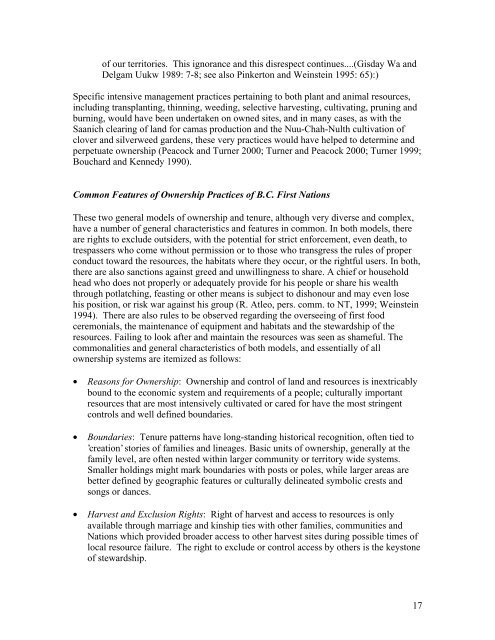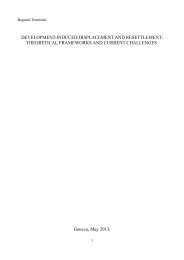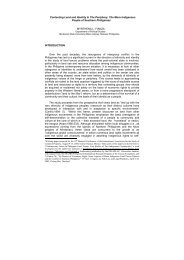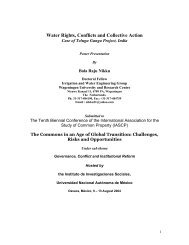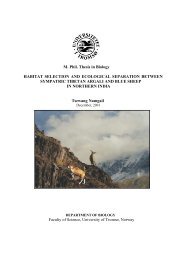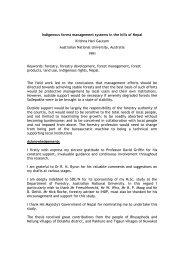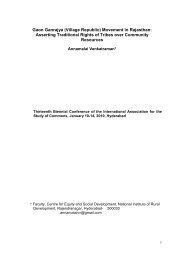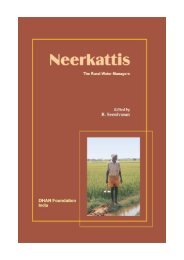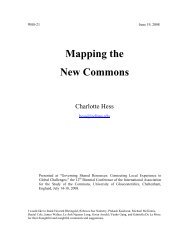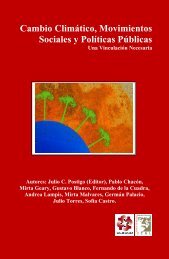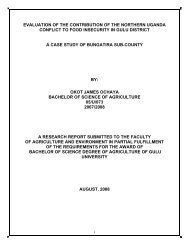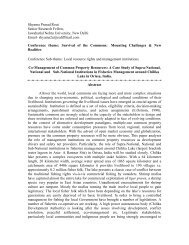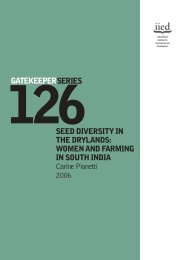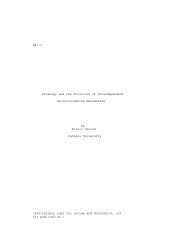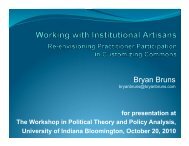Charles Newcombe (1902: Haida - Ksaan Notebook: vol 35, frame 000833), also notedthat in <strong>the</strong> annual construction of weirs by <strong>the</strong> Haida, "<strong>the</strong> uprights made of hemlock[were] left in place to make each family’s territory" in <strong>the</strong> case of a multi-use streamfishery. Even seabird nesting sites were owned by given families:<strong>The</strong> eggs of sea birds and especially those of <strong>the</strong> large white gull, are collected ingreat quantities in <strong>the</strong> early summer. Every lonely and wave washed rock on which<strong>the</strong>se birds deposit <strong>the</strong>ir eggs, is known to <strong>the</strong> natives, who have even <strong>the</strong>se,apportioned among <strong>the</strong> families as hereditary property (Dawson 1878: 134b).Weinstein (1994: 3) described a similar system for <strong>the</strong> Nisga’a:<strong>The</strong> land of <strong>the</strong> Nass River Drainage and adjacent coastal areas were divided intoterritories or ango’oskws. <strong>The</strong> boundaries of a territory typically radiated upmountain slopes to <strong>the</strong> mountain tops, framing a salmon stream in between. <strong>The</strong>territory design provided each house with access to <strong>the</strong> full array of Nass resourcezones: alpine, sub-alpine, mid-slope, bottom lands, and riparian or marine shore.Each house had exclusive ownership rights to <strong>the</strong>ir territory and its resources. <strong>The</strong>separation of land into wilp controlled ango’oskws was <strong>the</strong> basis for <strong>the</strong> traditionalmanagement system for fisheries and for o<strong>the</strong>r natural resources.Each territory was collectively owned by <strong>the</strong> wilp, but actual title was tied to <strong>the</strong>chief's name. <strong>The</strong> chiefs had ultimate authority over <strong>the</strong> territory and its resources,although decisions were typically made in consultation with a council of <strong>the</strong> wilp'ssub-chiefs. Nisga'a laws of chiefly conduct speaks clearly about <strong>the</strong> chief's role assteward of both his territory and his people, ra<strong>the</strong>r than ruler.As explained by Gisday Wa and Delgam Uukw (1989: 7-8, this type of geographicallyand culturally based system of resource access, use, ownership and relationship with <strong>the</strong>environment is also characterized for <strong>the</strong> Gitxsan:For us, <strong>the</strong> ownership of territory is a marriage of <strong>the</strong> Chief and <strong>the</strong> land. EachChief has an ancestor who encountered and acknowledged <strong>the</strong> life of <strong>the</strong> land.From such encounters come power. <strong>The</strong> land, <strong>the</strong> plants, <strong>the</strong> animals and <strong>the</strong>people all have spirit--<strong>the</strong>y all must be shown respect. That is <strong>the</strong> basis of ourlaw.<strong>The</strong> Chief is responsible for ensuring that all <strong>the</strong> people in his House respect <strong>the</strong>spirit in <strong>the</strong> land and in all living things.... With <strong>the</strong> wealth that comes fromrespectful use of <strong>the</strong> territory. <strong>The</strong> House feeds <strong>the</strong> name of <strong>the</strong> Chief in <strong>the</strong> FeastHall. In this way, <strong>the</strong> law, <strong>the</strong> Chief, <strong>the</strong> territory, and <strong>the</strong> Feast become one. <strong>The</strong>unit of <strong>the</strong> Chief's authority and his House's ownership of its territory arewitnessed and thus affirmed by <strong>the</strong> o<strong>the</strong>r Chiefs at <strong>the</strong> Feast. By following <strong>the</strong>law, <strong>the</strong> power flows from <strong>the</strong> land to <strong>the</strong> people through <strong>the</strong> Chief; by using <strong>the</strong>wealth of <strong>the</strong> territory, <strong>the</strong> House feasts its Chief so he can properly fulfill <strong>the</strong> law.This cycle has been repeated on my land for thousands of years.... <strong>The</strong> Europeansdid not want to know our histories; <strong>the</strong>y did not respect our laws or our ownership16
of our territories. This ignorance and this disrespect continues....(Gisday Wa andDelgam Uukw 1989: 7-8; see also Pinkerton and Weinstein 1995: 65):)Specific intensive management practices pertaining to both plant and animal resources,including transplanting, thinning, weeding, selective harvesting, cultivating, pruning andburning, would have been undertaken on owned sites, and in many cases, as with <strong>the</strong>Saanich clearing of land for camas production and <strong>the</strong> Nuu-Chah-Nulth cultivation ofclover and silverweed gardens, <strong>the</strong>se very practices would have helped to determine andperpetuate ownership (Peacock and Turner 2000; Turner and Peacock 2000; Turner 1999;Bouchard and Kennedy 1990).Common Features of Ownership Practices of B.C. First Nations<strong>The</strong>se two general models of ownership and tenure, although very diverse and complex,have a number of general characteristics and features in common. In both models, <strong>the</strong>reare rights to exclude outsiders, with <strong>the</strong> potential for strict enforcement, even death, totrespassers who come without permission or to those who transgress <strong>the</strong> rules of properconduct toward <strong>the</strong> resources, <strong>the</strong> habitats where <strong>the</strong>y occur, or <strong>the</strong> rightful users. In both,<strong>the</strong>re are also sanctions against greed and unwillingness to share. A chief or householdhead who does not properly or adequately provide for his people or share his wealththrough potlatching, feasting or o<strong>the</strong>r means is subject to dishonour and may even losehis position, or risk war against his group (R. Atleo, pers. comm. to NT, 1999; Weinstein1994). <strong>The</strong>re are also rules to be observed regarding <strong>the</strong> overseeing of first foodceremonials, <strong>the</strong> maintenance of equipment and habitats and <strong>the</strong> stewardship of <strong>the</strong>resources. Failing to look after and maintain <strong>the</strong> resources was seen as shameful. <strong>The</strong>commonalities and general characteristics of both models, and essentially of allownership systems are itemized as follows:• Reasons for Ownership: Ownership and control of land and resources is inextricablybound to <strong>the</strong> economic system and requirements of a people; culturally importantresources that are most intensively cultivated or cared for have <strong>the</strong> most stringentcontrols and well defined boundaries.• Boundaries: Tenure patterns have long-standing historical recognition, often tied to’creation’ stories of families and lineages. Basic units of ownership, generally at <strong>the</strong>family level, are often nested within larger community or territory wide systems.Smaller holdings might mark boundaries with posts or poles, while larger areas arebetter defined by geographic features or culturally delineated symbolic crests andsongs or dances.• Harvest and Exclusion Rights: Right of harvest and access to resources is onlyavailable through marriage and kinship ties with o<strong>the</strong>r families, communities andNations which provided broader access to o<strong>the</strong>r harvest sites during possible times oflocal resource failure. <strong>The</strong> right to exclude or control access by o<strong>the</strong>rs is <strong>the</strong> keystoneof stewardship.17
- Page 2 and 3: settlement. Notably, the template f
- Page 4 and 5: Indigenous Group(Language Family);R
- Page 6 and 7: Sekani, Dakelh or Carrier,Tsilhqot
- Page 8 and 9: families," and the use by others re
- Page 10 and 11: ask permission to use the traps fro
- Page 12 and 13: ... in the case of a salmon stream,
- Page 14 and 15: As well as gardens, patches and sta
- Page 18 and 19: • Succession:: Territories and si
- Page 20 and 21: The burgeoning field of traditional
- Page 22 and 23: longest time", which became the fou
- Page 24 and 25: Barnett, Homer G. 1955. The Coast S
- Page 26 and 27: Hamori-Torok, Charles. 1990. Haisla
- Page 28 and 29: Richardson, Allan. 1976. The Contro
- Page 30: email to Nives Dolsak and Elinor Os


